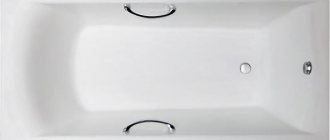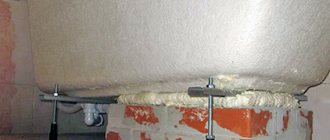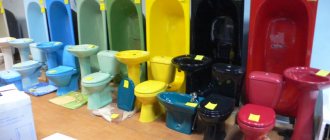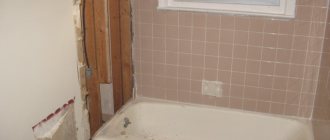At the renovation stage, the question of replacing the bathtub is relevant. The choice is rich enough to get lost in the store's offerings. Based on cost, steel products are preferred. Acrylic products have interesting shapes, while cast iron products provide reliability and strength. Unlike the now fashionable plastic structures, the history of the latter dates back to 300 years of fame, and they are still actively purchased. If there is a wide choice of models, then there is a demand for them. Sometimes aesthetic benefits trump logic.
The bathroom area is not happy with the extra meters, and you have to think about whether you should choose a shower stall with a deep tray over a bathtub. If the reason for the choice is comfort, then the decision is in favor of the bowl. And since every centimeter is precious, it is worth indicating the dominant or its absence in the corner version.
Will such a design really save space and become a modern alternative to the old classics, as the manufacturers claim? They convince us that the corners of rectangular models do not belong to the useful surface, but only “cut off” the area. Let's try to confirm or refute the statement with facts.
Corner cast iron bathtub: past and present
Most Russians, trying to give their bathroom a modern look, get rid of cast iron bathtubs
to install a non-standard corner bathtub model. True fans of natural materials and connoisseurs of pleasant hygienic procedures understand that a cast iron bathtub is a real wealth. The consumer qualities of a corner cast-iron bathtub prove that all the best is the well-forgotten old.
The technical characteristics of cast iron models are beyond doubt; steel and acrylic analogues are inferior to them in many respects. Modern manufacturers of sanitary equipment have successfully solved the problem of the aesthetic appeal of cast iron products. The market offers a wide range of cast iron bathtubs by color, options for cast iron corner bathtubs by size, cast iron bathtubs with hydromassage functions
.
A little criticism
In the sizes of corner baths, unlike conventional ones, the length of the rod is reduced by 200 mm.
It turns out that when purchasing a 1.7 m structure, in reality we get the same result - the advantages of an ordinary half-meter font. The standard 1.5 m model occupies 1.05 square meters. m. area. The width of the corner analogue, when calculated, leads to almost the same figure = 1.45 m. In addition, after installation, the opposite corner remains unused, for the reason that practically nothing fits into a small niche.
Cult of pure body and pure spirit
In Rus' the cult of the clean body has always been revered. In addition to public baths for city residents, in villages a log bathhouse was built . Traditional rules of bathing procedures can be considered as a separate culture. It represents an organic combination of unitary tasks with a certain ritual and intimate conversations. The well-known men's trips to the bathhouse strengthened male friendship. Steam room, brooms, resinous steam, linden tea are indispensable attributes of a Russian bath.
Cast iron bathtubs appeared in Russia under Peter I. At first, the bathroom was only in palaces and rich mansions. With the development of cities, cast iron baths appeared in city apartments. A cast iron bathtub was installed in every Khrushchev house. Even in conditions of poor living and cramped conditions, weekly bath days are an unshakable rule of Russian life.
For interior
For a room to look harmonious, all elements must be combined. And therefore, the bathtub must be selected according to the interior design, and not vice versa. As a result, when choosing a cast iron product, you should already have an idea of what the room will look like.
The variety of modern models is amazing, so everyone can choose a product according to shape, color, size and other parameters. Two types of models can be distinguished:
- free-standing - installed on beautiful legs, used most often in spacious rooms;
- built-in – a traditional type, which is covered with a special screen made of any material.
The most common and universal color is white. For cast iron products this is the most popular solution.
Corner cast iron bathtub in all its glory
Enlightened Europe considered Russians barbarians because they had the habit of washing in a bathhouse once a month. The famous Roman baths sank into oblivion with the advent of Christianity. The Catholic Church viewed hygiene procedures as sensual pleasure, so nudity and bathing were considered sinful. It was not only commoners who became victims of hygiene restrictions. Isabella of Castile, Queen of Spain, did not hide the fact that she bathed twice in her life: at birth and before her wedding.
Acrylic - sizes and shapes
Acrylic is a durable, chemically neutral polymer with a wide range of applications. They also make baths from it. Moreover, acrylic bathtubs come in a variety of shapes and sizes. They come in round, oval, angular, and complex shapes (in the form of a bean, for example). The walls may not be straight, but rounded, with smooth bends. The bottom may have steps; there are often seats, recesses, armrests and other “excesses” that make operation more convenient. Various sprayers and nozzles for hydromassage are built into an acrylic bathtub.
Advantages and disadvantages
Acrylic is a much less heat-intensive material than steel and cast iron. This means that it heats up faster. And this is another plus. The next positive quality is that it is lightweight. A bathtub of any size made of acrylic can be easily carried by one person. Another positive point: the size of the acrylic bathtub can be ordered. The material is plastic, it can be given any shape, and the technology is such that you can make a container both large and small.
Oval bathtub for non-standard interiors
A round one can only be placed in a spacious room
Asymmetrical shapes are also common
Acrylic can be colored
The size of a bathtub installed in a corner is calculated by the length of the side
With built-in hydromassage
Smooth curved shapes reduce the likelihood of injury
The frame is covered with a screen
Now about the disadvantages. The walls of the acrylic bathtub are thin and bend under load. Not the most pleasant feeling. Therefore, any acrylic bathtub is installed on a frame made of metal or bricks (building blocks), the frame itself is then covered with a screen.
Attention to the quality of acrylic
Durability and ease of maintenance depend on the quality of the polymer used. The best is plumbing acrylic poured onto a fiberglass base in a layer of at least 2-3 mm. But such copies cost a lot. Often more expensive than steel ones, and the prices of some acrylic bathtubs are no less than cast iron ones. But they last a long time and wash well. By the way, caring for an acrylic bathtub is special. It can only be washed with certain sponges and special non-abrasive products.
The sizes of acrylic bathtubs should be described by shape, as they come in different shapes.
- Standard form. Length from 140 to 185 cm, width 75-90 cm, depth 40 - 65 cm.
- Round. Diameter from 140 to 200 cm, but can be larger.
- Angular. Here I determine the dimensions by the length of the side - from 140 cm to 180 cm, depth - 45-65 cm.
It is difficult to determine the size of unusual shapes. They are usually supplied to order or specially manufactured. So if you need a bathtub size exactly for your room or an unusual shape, your choice is clear - acrylic.
Corner cast iron bath: Types
Europe was saved by the French boilermaker Level: the enterprising Frenchman established mass production of metal bathtubs . Cast iron is a heavy and brittle metal, so cast iron bathtubs have been replaced by steel ones
models. They were 3-4 times lighter, but the water in the steel bath cooled quickly, and this was a significant drawback. The loud sound from the stream of pouring water caused discomfort.
The twentieth century brought joy with new inventions: acrylic bathtubs were made from polymethyl methacrylate by casting. Containers of various configurations are formed from the blank sheet by heat treatment. Using pigment, a bath of any color is obtained; with special processing, a product with a floral print or geometric pattern is obtained. Knowing the qualities and properties of the material from which the bathtub is made, you can choose the best option for your bathroom:
- A bathtub made of cast iron covered with enamel was considered a luxury, but it became widespread in the 20th century. The heavy weight of these models is considered a disadvantage at the stage of transportation and installation. During operation, heavy-weight, impact-resistant, sound- and heat-insulating cast iron is an important advantage
of the bathtub. - A steel bathtub is much lighter than its cast iron counterpart, durable in use, but does not have heat retention properties.
- The acrylic model is very light and more susceptible to mechanical damage. During installation, additional strengthening measures are required. Acrylic bathtubs come in a variety of shapes and colors.
Who should you buy from?
Domestic products dominate sales. It differs from imported analogues in the thickness of the walls: their bowls are made of 5 mm cast iron, but the slight difference in favor of Russian models does not affect the high European quality. They look more elegant and are equipped with comfortable handles, a screw device for height adjustment, beautiful fittings and little things that provide pleasant relaxation.
Models from Kohler (USA) are especially interesting. The company has a rich history in the production of plumbing fixtures, and judging by some products costing 150,000 rubles , perhaps there is no need to doubt the design and quality. Competing with the American manufacturer are Jacob Delafon (France), Odoksan (Turkey), Goldm (China). The brand and material determine the cost. Thus, ROKA is sold for 12,000–18,000 rubles. Economy class models range from 7,000 to 8,000 rubles.
The price of Russian models from the Kirov plant starts from 5,000 rubles, from Novokuznetsk - from 7,000 rubles. Chrome elements and related accessories for equipment add to the price from 700 to 1800 rubles.
Corner cast iron bathtubs save space and give a pleasant feeling
In a small bathroom, a corner cast iron bathtub solves the problem of limited space. Corner model fits well into a small room, non-standard configuration
allows you to create an original interior in an ordinary bathroom.
- The triangular symmetrical bathtub has a right angle that conveniently occupies the corner of the bathroom;
- An asymmetrical diamond-shaped bathtub is the best option for a small room;
- Left- and right-hand corner cast iron bathtubs are purchased depending on the bathroom layout;
- A corner cast-iron bathtub in the form of a rounded triangle is placed in a free corner of the room;
- Shell, semi-open fan - exclusive shapes of corner cast iron bathtubs are made to order.
Of course, it is difficult to make extravagant bathtubs in the form of a woman's shoe, carriage, car, flower, coffee cup or bookcase from cast iron. Manufacturers of modern corner cast iron bathtubs guarantee
maximum pleasure and comfort.
Dimensions of standard baths
The choice of plumbing is one of the important points in the design of a bathroom in a house or apartment. Particular attention is paid to the choice of bathtub. This plumbing fixture is the largest in a small room, and when planning, the first thing to decide is where to put the bathtub and what size it can be. There are standard and non-standard options on sale. The good thing about standard ones is that, if necessary, you can order an acrylic liner for the bathtub and thereby restore its appearance and extend its service life. For non-standard customers this restoration option is not available. They can only be updated using self-leveling acrylic.
Standard size of steel bathtub
What else is good about bathtubs of standard sizes - they are always in stock, you can see and touch them. Non-standard, most often, is brought to order. You can't feel it first. But standard containers are not always the best solution, since they do not always make the best use of the available space.
There are bathtubs of two standards on the market - Russian (post-Soviet) and European “origin”. They are not very different, but these centimeters can be very useful.
| Name | Russian standard | European standard |
| Length | 150-170 cm | 150-180 cm |
| Width | 70-75 cm | 70-85 cm |
| Depth | 40-50 cm | 50-65 cm |
| Wall angle | 50-80° |
Coating
You need to carefully examine the surface of the bathtub. Cast iron is a rather complex metal in terms of making similar products from it, so getting a flat surface is not an easy task. If it is smooth and uniform in color, manufacturing standards have been met - the quality is the highest.
After this, you can inspect the walls from the outside. They should not have any defects. It’s great if powder enamel is applied to this surface, which makes the product look presentable and protected.











